Input interpretation

2, 3-dibromo-2-butene-1, 4-diol
Chemical names and formulas
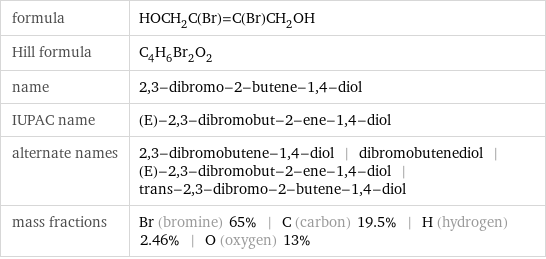
formula | HOCH_2C(Br)=C(Br)CH_2OH Hill formula | C_4H_6Br_2O_2 name | 2, 3-dibromo-2-butene-1, 4-diol IUPAC name | (E)-2, 3-dibromobut-2-ene-1, 4-diol alternate names | 2, 3-dibromobutene-1, 4-diol | dibromobutenediol | (E)-2, 3-dibromobut-2-ene-1, 4-diol | trans-2, 3-dibromo-2-butene-1, 4-diol mass fractions | Br (bromine) 65% | C (carbon) 19.5% | H (hydrogen) 2.46% | O (oxygen) 13%
Lewis structure
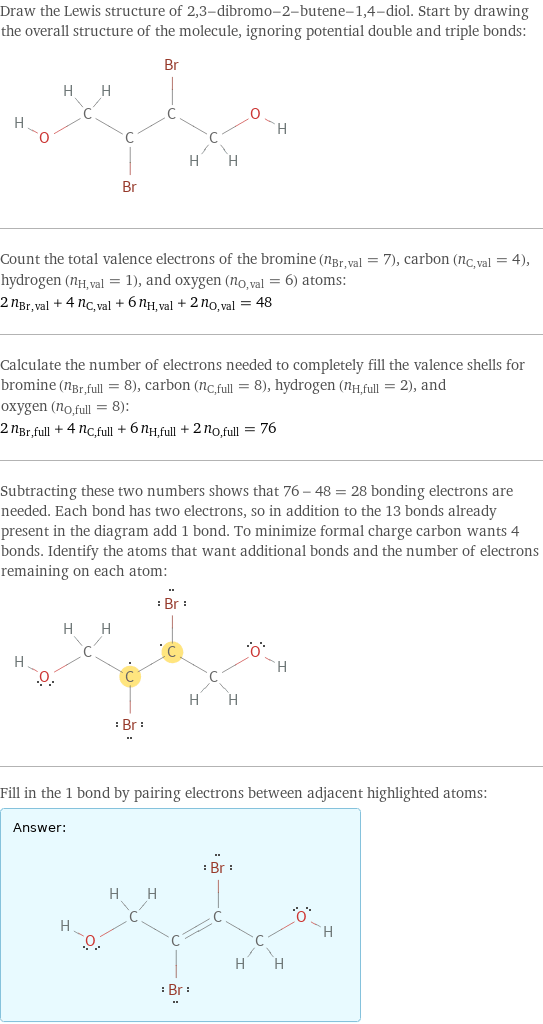
Draw the Lewis structure of 2, 3-dibromo-2-butene-1, 4-diol. Start by drawing the overall structure of the molecule, ignoring potential double and triple bonds: Count the total valence electrons of the bromine (n_Br, val = 7), carbon (n_C, val = 4), hydrogen (n_H, val = 1), and oxygen (n_O, val = 6) atoms: 2 n_Br, val + 4 n_C, val + 6 n_H, val + 2 n_O, val = 48 Calculate the number of electrons needed to completely fill the valence shells for bromine (n_Br, full = 8), carbon (n_C, full = 8), hydrogen (n_H, full = 2), and oxygen (n_O, full = 8): 2 n_Br, full + 4 n_C, full + 6 n_H, full + 2 n_O, full = 76 Subtracting these two numbers shows that 76 - 48 = 28 bonding electrons are needed. Each bond has two electrons, so in addition to the 13 bonds already present in the diagram add 1 bond. To minimize formal charge carbon wants 4 bonds. Identify the atoms that want additional bonds and the number of electrons remaining on each atom: Fill in the 1 bond by pairing electrons between adjacent highlighted atoms: Answer: | |
3D structure
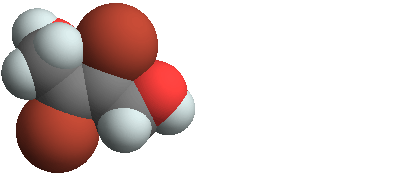
3D structure
Basic properties
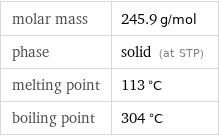
molar mass | 245.9 g/mol phase | solid (at STP) melting point | 113 °C boiling point | 304 °C
Units

Thermodynamic properties

critical temperature | 763 K critical pressure | 6.74 MPa (at STP)
Chemical identifiers
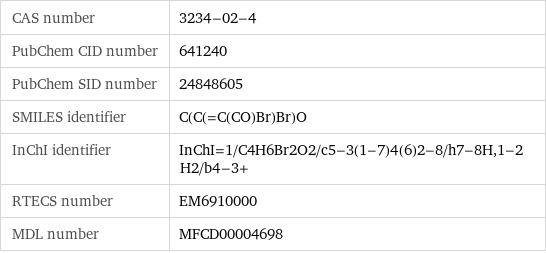
CAS number | 3234-02-4 PubChem CID number | 641240 PubChem SID number | 24848605 SMILES identifier | C(C(=C(CO)Br)Br)O InChI identifier | InChI=1/C4H6Br2O2/c5-3(1-7)4(6)2-8/h7-8H, 1-2H2/b4-3+ RTECS number | EM6910000 MDL number | MFCD00004698
NFPA label

NFPA label
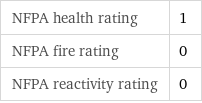
NFPA health rating | 1 NFPA fire rating | 0 NFPA reactivity rating | 0
Toxicity properties

RTECS classes | mutagen